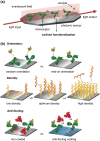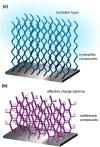Biochemistry strategies for label-free optical sensor biofunctionalization: advances towards real applicability
- PMID: 34735605
- PMCID: PMC9242939
- DOI: 10.1007/s00216-021-03751-4
Biochemistry strategies for label-free optical sensor biofunctionalization: advances towards real applicability
Abstract
Label-free biosensors, and especially those based on optical transducers like plasmonic or silicon photonic systems, have positioned themselves as potential alternatives for rapid and highly sensitive clinical diagnostics, on-site environmental monitoring, and for quality control in foods or other industrial applications, among others. However, most of the biosensor technology has not yet been transferred and implemented in commercial products. Among the several causes behind that, a major challenge is the lack of standardized protocols for sensor biofunctionalization. In this review, we summarize the most common methodologies for sensor surface chemical modification and bioreceptor immobilization, discussing their advantages and limitations in terms of analytical sensitivity and selectivity, reproducibility, and versatility. Special focus is placed on the suggestions of innovative strategies towards antifouling and biomimetic functional coatings to boost the applicability and reliability of optical biosensors in clinics and biomedicine. Finally, a brief overview of research directions in the area of device integration, automation, and multiplexing will give a glimpse of the future perspectives for label-free optical biosensors.
Keywords: Antibody immobilization; Antifouling coating; Biochemical cross-linking; Lipid membrane; Silicon photonics; Surface plasmon resonance.
© 2021. The Author(s).
Conflict of interest statement
The authors declare no competing interests.
Figures





References
-
- Lopez GA, Estevez M-C, Soler M, Lechuga LM. Recent advances in nanoplasmonic biosensors: applications and lab-on-a-chip integration. Nanophotonics. 2017;6:123–136. doi: 10.1515/nanoph-2016-0101. - DOI
Publication types
MeSH terms
Substances
Grants and funding
LinkOut - more resources
Full Text Sources

